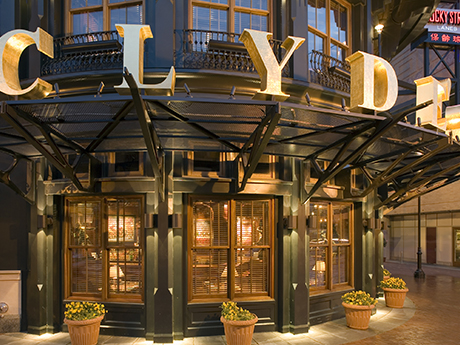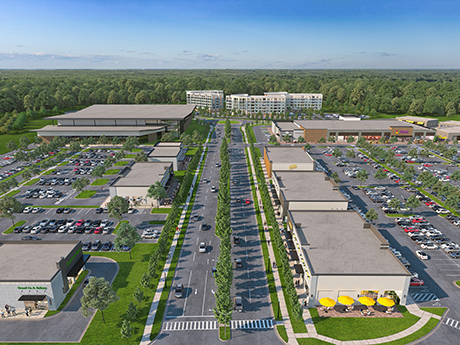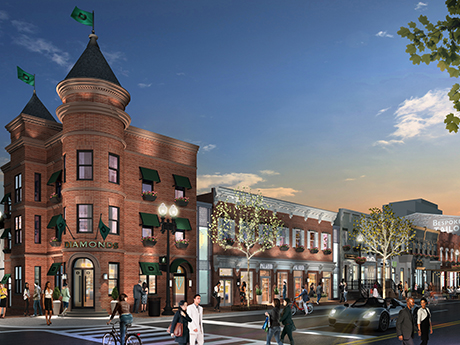Brokers, owners and developers active in the Mid-Atlantic’s retail sector describe a market buoyed by a strong consumer base, though the landscape varies somewhat across urban and suburban areas.
Even as the Mid-Atlantic contends with higher interest rates and a drop in daytime traffic within urban centers as a result of new work-from-home practices, retail in the region continues to shine.
According to sources interviewed for this article, the market — despite these economic headwinds and uncertainties — is thriving and as strong as ever. As Richard Lake of Roadside Development summarizes it, “it’s a very strong market with tight vacancy.”
One developer’s loss
In April of this year, developer JBG Smith announced the cancellation of plans for an entertainment district in metro Washington, D.C. Dubbed Potomac Yards, the cancelled entertainment district project was to be constructed within the National Landing neighborhood in Alexandria, Virginia. However, Washington D.C. Mayor Muriel Bowser inked a deal with the Capitals and Wizards teams to keep them at their existing home, the Capital One Arena in D.C.
One developer’s disappointment, though, can be another owner’s gain.Global Fund Investments had recently acquired Gallery Place — a retail property adjacent to Capital One Arena — in partnership with MRP Realty. Though Robert Hoffman, a principal with Global Urban, an offshoot of Global Fund Investments, says that Global was prepared to acquire Gallery Place in the absence of the teams, their presence at the site for the next 25 years will serve as an anchor.
According to Hoffman, tenants at Gallery Place have also been bullish on the future of the property, even when staring down the impending departure of the Capitals and Wizards. “Every single one of them was all-in on staying long term,” says Hoffman.

Now though, Global can plan on the teams being “a long-term partner” and “active on our site just as much as they’re active in Capital One,” Hoffman elaborates.
That is not to say that Gallery Place (along with D.C. on the whole) has not faced its own fair share of challenges. At the time of Global Urban and MRP’s acquisition, the property had already fallen into the “distressed” category. This is owing in part to the fact that a number of leases originally signed roughly 20 years ago recently expired and were not renewed. Tenants that departed the site included Urban Outfitters, Anthropologie and Bed Bath & Beyond, which had already gone into bankruptcy and closed by the end of its lease. Regal Cinemas Gallery Place, though currently still operating, is also due to close soon.
Hoffman believes that conditions will only improve moving forward, particularly with the city’s $515 million investment into Capital One Arena.
Work from home woes
Though Washington, D.C., is already reaping the benefits of a concerted effort to combat crime, it is less clear what the future will bring for downtown office vacancy, and therefore daytime retail traffic in urban areas.
As Bill Miller, principal and cofounder of Miller Walker Real Estate, observes, the Mid-Atlantic region is not immune to the domino effects of new work-from-home practices playing out elsewhere in the country. “Like many other cities, we’re suffering from the same return-to-work [patterns],” says Miller of D.C.
Some owners and developers are responding to the headwinds facing the office sector by converting office properties for residential uses. According to Miller, this can enrich retail by creating “more of a mixed-use and healthier, more stable environment.”
It is also important to point out that not all office properties in the Mid-
Atlantic are in dire straits. For instance, the Homer building, a Class A office development located atop the Metro Center station in D.C., is currently 85 percent leased.
Miller also points to what he says is a “flight to quality,” with those interested in having offices downtown “looking to go into trophy assets” and getting better deals.
In addition to new work-from-home induced challenges, urban retail — and retail across all submarkets — is encountering the same economic headwinds currently hitting the rest of the country. These include high interest rates and high costs of new development.
Mike Howard, executive director of brokerage with Rappaport, points out current interest rates can lead to
a lack of delivery, even where demand is strong, because developers can’t
get financing for some large-scale projects.
D. Wright Sigmund of Sigmund Cos. agrees that while smaller groups especially may be “constrained” at the moment, there is a lot of new interest in retail spaces, particularly those within the necessity and grocery categories.
Residents drive retail, grocery goes the distance
Factors including diminished office usage have led to different dynamics within Mid-Atlantic submarkets, with particular distinction between more urban and residential areas.
“If you’re a suburban shopping center, you’re probably the happiest you have ever been,” says Howard. “You have little to no vacancy, your rents are sky high and there are people lining up to lease space that you don’t even have vacant yet.”
Gary Michael of NAI Michael Cos., which is primarily involved in traditional, grocery-anchored suburban retail, echoes this sentiment. “It’s as strong as I can remember,” Michael relays. “Rents are going up, our vacancies are extremely low, and it’s a very vital market.”
“Retail wants to be where people live and work,” says Lake, emphasizing that now those two places are often one and the same, leading to greater strength in the suburban markets.
Sigmund observes that areas such as Arlington County [Virginia] and Montgomery County [Maryland] are “extremely competitive for retail space,” especially with a limited amount of new space coming online.
On the other hand, retail in the more urban and office-centric trade areas is “surviving” rather than “thriving,” according to Howard and Miller. In their view, it is D.C.’s tourist traffic that is a saving grace in those office-centric submarkets.
Lake concurs that the health of the retail submarket is “really driven by location” and that there will continue to be a struggle in the areas dependent on office traffic until there is “a new normal level of activity and energy back downtown.”
MCB Real Estate and Generation Properties broke ground in May on Armory Square, a 110,000-square-foot shopping center in Prince Frederick, Maryland. Grocer Aldi will anchor the center. The Fresh Market recently announced plans to anchor two mixed-use developments in Northern Virginia. In addition to existing locations in Alexandria and Vienna, Virginia, the grocer will soon occupy 27,000 square feet of space at Reston Station — a project in Reston by Comstock Cos. — and 29,000 square feet at West Falls, a 10-acre project in Falls Church by Hoffman & Associates.

A moment for mixed-use
Along with grocery-anchored shopping centers, many commercial real estate executives in the Mid-Atlantic highlight mixed-use properties as one of the retail sector’s stars of the moment.
In Baltimore, a $5 billion mixed-use redevelopment project — Baltimore Peninsula — is currently underway. Totaling 14 million square feet across 235 acres, the development includes a four-acre sports venue, ROOST Apartment Hotel and the residential communities Rye House and 250 Mission. MAG Partners and MacFarlane Partners are among the developers involved in the creation of Baltimore Peninsula.
NAI Michael Cos. is also underway on a mixed-use development located in Bowie, Maryland. Upon completion, the $1.3 billion project — South Lake Marketplace — will total 600,000 square feet. Much like Gallery Place, sports will serve as a draw for the development, which will be situated adjacent to Liberty Sports Park. The latter features 10 professional sports fields and attracts 344,000 tournament attendees annually, according to NAI Michael Cos.
Retail at the development will also serve the residents occupying the 1,600 residential units included in the project, as well as other nearby residents. “We’re really trying to satisfy the needs for the bigger, urban housing developments around us,” says Michael.
Other entertainment-based projects are moving forward elsewhere in the Mid-Atlantic region, aligning with the focus on experiential retail at large.
In Petersburg, Virginia, roughly 24 miles south of Richmond, the city has selected Bruce Smith Enterprise and The Cordish Cos. to develop a $1.4 billion gaming and entertainment district. Dubbed Live! Casino & Hotel Virginia, the development will comprise more than 400,000 square feet of gaming, hotel and dining space, as well as 35,000 square feet of meeting and convention space; a 200-room hotel; 1,600 slot machines; 46 table games; a sportsbook; 3,000-seat entertainment venue; and eight food-and-beverage concepts.
Educated and eager to spend
As another point of distinction, Mike Howard notes that the Mid-Atlantic is not only densely populated, but also highly educated. Miller concurs, noting that the D.C. metro has the distinction of the “highest average educational attainment.” Aside from a population distinguished by its education level and level of disposable income, the Mid-Atlantic is set apart by virtue of being home to the nation’s capital — D.C., perhaps the region’s crowning jewel. Tourism aside, Miller points out that people are drawn to Washington, D.C., to be close to the government for purposes including “lobbying, doing business or being a contractor.”
Sigmund also notes that “there is a good sector of technology and thought leadership, because of the large number of universities spread throughout the Mid-Atlantic.”
And, as Robert Hoffman says, “if you believe in the United States, you better believe in D.C.”
— Hayden Spiess
This article was originally published in the August 2024 issue of Shopping Center Business magazine.


